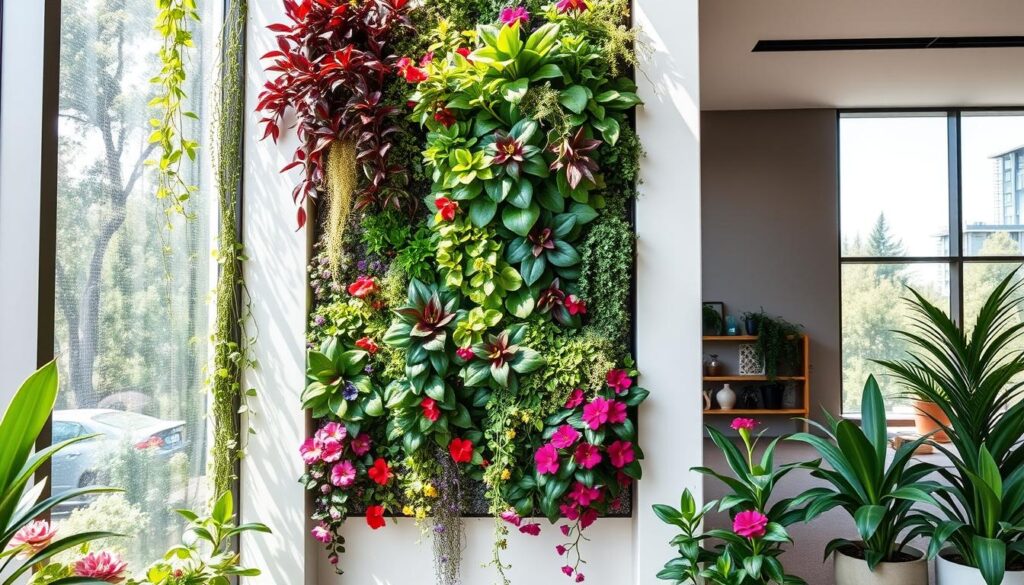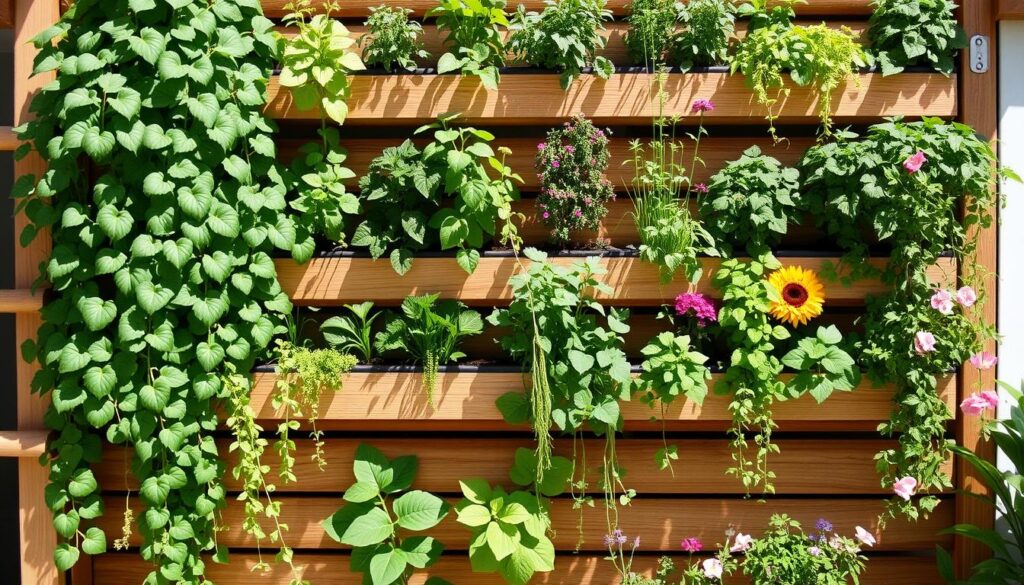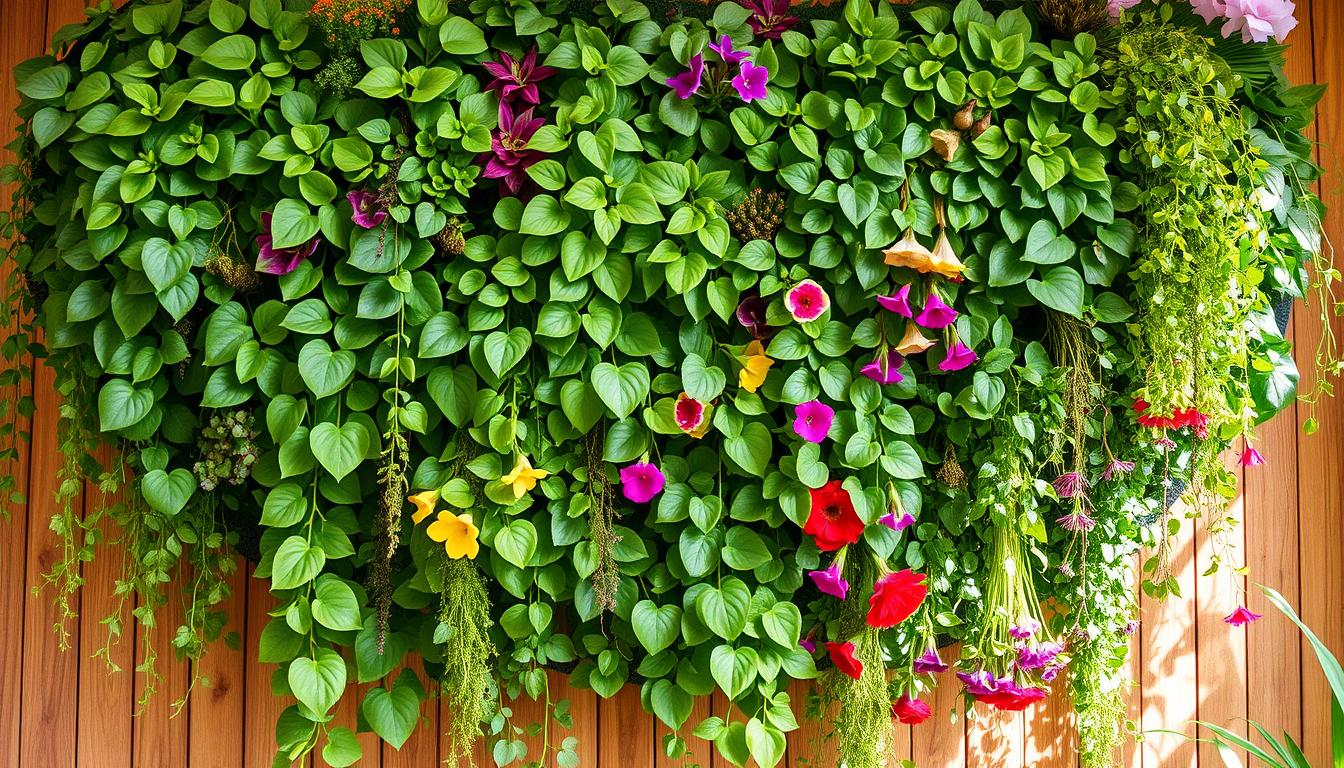Imagine stepping into your home and finding a lush, green oasis. This magical scene is possible with vertical gardening. It works in any space, big or small, turning your home into a peaceful, natural retreat.
As a gardener, I love how we can bring nature indoors. Vertical gardening is especially exciting. It lets us grow beautiful gardens in tight spaces, bringing life and calm to our homes.
Table of Contents
We’ll explore vertical garden benefits, planning, and design next. We’ll also show you how to create a stunning vertical garden in your home. Get ready to turn your space into a vibrant, calming oasis that refreshes your soul.
Understanding Vertical Gardens: Benefits and Basics
Exploring vertical gardening shows many benefits for our planet and health. These gardens save space, perfect for city living. They let you grow many plants in small areas.
Environmental Impact and Space Optimization
Vertical gardens clean the air by removing pollutants and adding oxygen. They also save energy by insulating and shading, cutting down on cooling and heating needs. In busy cities, they make the most of every inch, turning small spaces into green oases.
Health Benefits of Living Walls
Vertical gardens, especially living walls, lower stress and improve air quality. They bring a calming effect, boosting mental health and our connection to nature. Plus, they filter out harmful particles, making the air we breathe cleaner.
“Integrating vertical gardening practices into your home or office is a simple yet impactful way to promote a healthier, more sustainable lifestyle.”
Planning Your Indoor Vertical Garden Space
Creating a stunning vertical garden starts with planning your indoor space. The right spot and setup are key to success. Let’s look at what to consider for your indoor vertical garden.
First, measure the space for your vertical garden. Think about the area’s height, width, and depth. Also, watch out for any obstacles that might affect where you place it.
Next, check the lighting. Plants need the right light to grow well. Look at the natural and artificial light in your chosen spot. See if there are windows or grow lights to help.
- Choose a spot with at least 6 hours of direct sunlight a day. Or use grow lights if needed.
- Make sure the area is bright but not too sunny. Direct sunlight can burn the leaves.
After checking space and light, pick the best spot for your garden. Look for areas that are easy to reach, have good air flow, and are not too busy.
“The key to a thriving indoor vertical garden is finding the perfect balance between available space, lighting, and placement.”
Before installing, clean and level the space. You might need to make some changes. This could mean fixing walls, using special hardware, or building a base for your garden.
By planning well, you’ll create a beautiful and thriving vertical garden. With the right start, your gardening journey will be rewarding.
Essential Tools and Materials for Vertical Gardening
To grow a thriving vertical garden, you need the right tools and materials. You’ll need strong support systems and good irrigation solutions. Each part is key to a lush, green vertical garden. Let’s look at what you need to make your space a green oasis.
Support Systems and Mounting Hardware
The base of your vertical garden is the support system. Good trellises, wire frames, or wall panels keep plants stable. Choose durable, weather-proof materials for your setup.
Soil and Growing Medium Selection
Picking the right soil and growing medium is vital. Go for a mix that drains well and is full of nutrients. Think about pH balance, water retention, and air to help your plants grow well.
Irrigation Systems and Tools
- Drip irrigation systems: They send water straight to the roots, saving water and keeping moisture steady.
- Spray nozzles and misting systems: They create a fine spray to water plants gently and save water.
- Moisture meters: They help you know when to water, so you don’t over- or under-water.
With the right tools and materials, your vertical garden will thrive. It will look great and need little care. Start exploring and let your creativity grow!
Selecting the Right Plants for Your Vertical Garden
Choosing the right plants is key to a stunning vertical garden. You can turn your space into a lush oasis with the right picks. Think about these factors to pick the perfect plants for your garden.
First, check the lighting in your garden. Some plants love full sun, while others do better in shade or low light. Knowing what each plant needs helps your garden get the right light for growth.
Also, think about how the plants will grow. Choose plants that trail or cascade for a beautiful effect. Compact, upright plants add structure and order to your garden.
- Succulents, like Sedum and Echeveria, are great for vertical gardens. They’re easy to care for and come in many shapes.
- Trailing vines, such as Ivy and Pothos, add a lush feel to your space.
- Flowering plants, like Geraniums and Fuchsias, bring color and interest to your garden.
Think about how much care each plant needs. Some need more water or pruning, while others are low-maintenance. Pick plants that fit your gardening level and schedule.
“The beauty of a vertical garden lies in its ability to transform even the smallest of spaces into a verdant, visually captivating oasis.”
By considering these factors and exploring different plants, you can make a vertical garden that’s beautiful and eco-friendly. It will enhance your space and provide a sustainable living area.

Different Types of Vertical Garden Systems
Turning your living space into a lush oasis is easier than you think. There are many vertical garden systems to choose from. Whether you want to use every inch of space or make a bold statement, there’s a solution for you.
Pocket Planters and Hanging Systems
Pocket planters and hanging systems are great for small spaces. They let you grow different plants vertically, like succulents and vines. They’re also easy to move or add to as your space needs change.
Modular Wall Gardens
Modular wall systems create a stunning, full vertical garden. They turn any wall into a green wall. They’re easy to set up and work well indoors or outdoors.
Hydroponic Vertical Gardens
Hydroponic systems take vertical gardening to the next level. They use water instead of soil to feed plants. This method saves space and is low maintenance, perfect for city dwellers.
No matter your space or gardening skills, there’s a vertical garden for you. Think about your space, light, and how much time you have to care for it. With the right system, you can turn your home into a beautiful, natural oasis.
Step-by-Step Installation Guide
Creating a stunning vertical garden planter for your home is an exciting project. It can transform your living space. To ensure a successful installation, follow these step-by-step guidelines:
- Prepare the Wall: Start by thoroughly cleaning and prepping the wall surface where your vertical garden will be installed. This will help ensure proper adhesion and stability.
- Install the Support System: Choose a sturdy support system, such as a modular panel or a series of brackets, that can securely hold the weight of your plants and growing medium.
- Add the Growing Medium: Carefully fill the planter pockets or containers with a high-quality, well-draining garden practice soil or growing medium specifically designed for vertical gardens.
- Plant Selection and Placement: Select plants that thrive in the specific conditions of your vertical garden, and arrange them in a visually appealing manner.
- Ensure Proper Drainage: Incorporate drainage holes or a gravel layer at the bottom of the planter to prevent waterlogging and ensure the plants receive the right amount of moisture.
- Secure the Planter: Firmly attach the vertical garden planter to the support system, making sure it is level and stable.
By following these steps, you can create a lush and vibrant vertical garden planter. It not only enhances the beauty of your home but also provides numerous environmental and health benefits.
“Vertical gardening is a game-changer for small spaces, allowing you to maximize your garden practice and bring nature closer to you.”

Proper Watering and Irrigation Techniques
Keeping the right moisture levels is key for a successful vertical garden. You can choose between automated systems or manual watering. Learning how to water properly is essential for a healthy indoor garden.
Automated Watering Systems
Automated systems make watering your vertical garden easy. They use timers, sensors, and drip irrigation to give plants just the right amount of water. This way, your garden stays hydrated, even when you’re not around.
Manual Watering Best Practices
- Check the soil moisture by sticking your finger into it. Water when the top inch or two feels dry.
- Don’t let the soil dry out completely. This can stress your plants and slow their growth.
- Water the soil, not the leaves, to prevent diseases and keep plants healthy.
- Use a gentle watering method, like a watering can or a hose with a sprinkler, to avoid harming the plants.
- Change your watering schedule with the seasons, temperature, and humidity in your home.
Mastering watering, whether with automated systems or manual methods, is crucial. It ensures your vertical garden thrives and adds beauty to your space.
Maintenance Tips for a Thriving Vertical Garden
Keeping a vertical garden healthy needs some extra care. But the beauty it brings is worth it. By sticking to a regular care plan, your garden will stay lush and vibrant for years.
Pruning is key. Cutting back overgrown plants and removing dead leaves helps new growth. Always use sharp shears to avoid harming your plants.
Fertilizing is also vital. Use a balanced fertilizer and follow the instructions. This keeps the soil rich and supports your plants’ growth.
Watch for pests and diseases. Catching problems early helps prevent them from spreading. Act fast to remove pests or treat diseases.
Be ready to replace plants. Some may die or grow too big. Keep extra plants ready to keep your vertical garden looking great.
- Prune regularly to encourage new growth and maintain shape
- Fertilize every 2-4 weeks during the growing season
- Monitor for pests and diseases, and address issues promptly
- Replace plants as needed to keep your garden practice thriving
“A well-maintained vertical garden is a source of both beauty and serenity in the home.”
Common Challenges and Solutions
Keeping a vertical garden healthy needs hard work and solving problems. Two big issues are pests and plant diseases.
Pest Management Strategies
Pests like insects and rodents can trouble vertical gardens. Here are ways to handle them:
- Check your plants often for pest signs, like holes in leaves or color changes.
- Try organic pest control, like introducing good bugs or using neem oil, to keep pests away without harming your plants.
- Make sure your garden has good air flow and drainage to stop pests from gathering.
Plant Disease Prevention
Diseases can harm your vertical garden’s health and life span. Here’s how to prevent and deal with them:
- Pick plants that are resistant to diseases and fit your garden’s conditions.
- Keep the right amount of water and humidity to stop fungal growth.
- Quickly remove and throw away any sick plants to stop disease spread.
By tackling these common problems with smart strategies, your vertical garden can thrive and stay beautiful.
“A thriving vertical garden is the result of diligent pest and disease management.”
Design Ideas and Inspiration
Elevate your living space with a stunning vertical garden. Unleash your creativity and transform bare walls into lush, vibrant displays. From cascading succulents to trailing vines, the possibilities are endless.
Start by considering the overall aesthetic you wish to achieve. Do you envision a serene, monochromatic oasis or a vibrant, multicolored tapestry? Experiment with complementary plant pairings and play with texture and height for maximum visual impact.
For a modern, minimalist look, opt for a sleek, modular vertical garden system. Choose clean lines and a neutral color palette. Alternatively, embrace a more organic, natural vibe by incorporating reclaimed wood or stone elements into your vertical garden planter design.
“A vertical garden is not just a practical solution for small spaces, but a true work of art that can transform any room into a lush, inviting oasis.”
Take inspiration from the world around you, drawing ideas from natural landscapes, architectural details, or even your favorite artwork. By blending form and function, you can create a vertical garden that is both visually stunning and highly functional.
- Experiment with varying plant heights and textures for visual interest
- Incorporate pops of color through vibrant foliage or flowering plants
- Utilize reclaimed or repurposed materials for a unique, eco-friendly touch
- Integrate lighting to highlight your vertical garden’s stunning features
With a little creativity and a touch of green thumb, your vertical garden can become a true centerpiece in your home. It will spark joy and inspiration every time you gaze upon it.
Conclusion
Congratulations on starting your journey to create a beautiful vertical garden at home! You’ve discovered how vertical gardening can save space, improve air quality, and make your home look stunning. With the right planning and care, you’re ready to grow a vibrant vertical garden that adds joy to your life.
When you start your vertical gardening project, begin small and try out different plants. Enjoy the journey. A lush, green living wall will make all the effort worth it. You’ll feel proud and happy as you design and tend to your vertical garden.
Success in vertical gardening comes from your hard work, attention to detail, and openness to learning. This article has given you the tools to change your space for the better. So, get ready to plan your vertical garden and watch it grow!

